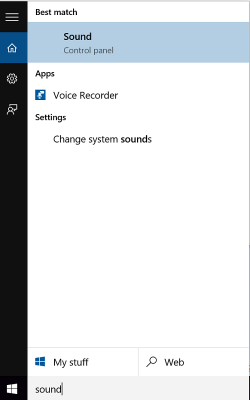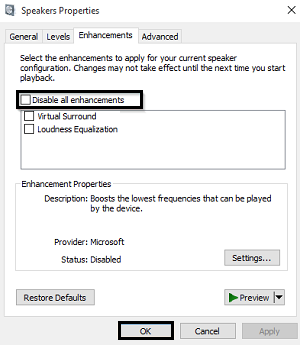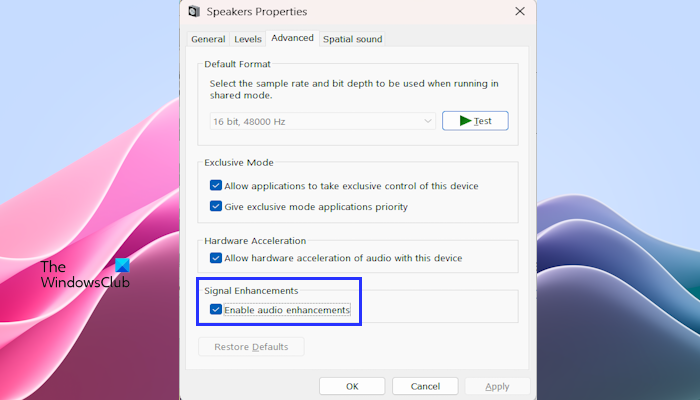Microsoft and third-party vendors have shipped audio enhancement packages designed to make your system’s specific hardware sound absolutely perfect. These are referred to as Audio Enhancements in Windows 11/10.
But sometimes, these very ‘enhancements’ can cause problems with audio and sound. If you face issues with your audio in Windows 11/10, you may want to disable Audio Enhancements and see if it helps.
If you see a message Windows has detected that audio enhancements for the following device are causing problems and you’re sure that your audio driver is up to date and you still experiencing the problem, and no audio works on your machine or you can’t play music, hear system sounds, or play any audio from the internet, try disabling the audio enhancement.
Windows 11 user? Read how to use Enhance audio feature on Windows 11.
Turn Off Audio Enhancements in Windows 11/10
In the taskbar search, type ‘Sound’ and select Sound Control Panel item from the list of results.

The Sound properties box will open. Under the Playback tab, right-click the Default Device – Speakers/Headphones and select Properties.

In the Speakers Properties box which opens, switch to the Enhancements tab, select the Disable all enhancements check box.

In Windows 11, you will see the setting here now:

Now try to play your audio device. Does it work? If so great!
If the method fails, select Cancel to go back to the Sound Properties box again. Now on the Playback tab, select another default device (if you have one), select the Disable all enhancements check box, and try to play audio again.
Do this for each default device.
This is how you can completely disable or turn off Audio Enhancements in Windows 11/10.
Read: How to disable or enable Loudness Equalization in Windows
Remember, you can always enable any enhancements disabled earlier if you feel the sound quality is not up to the mark. The enhancements enabled under the “Enhancements” tab are artificial software enhancements. If you prefer to use enhancements, you should select those that are included with your sound card software instead, as they provide more settings to adjust the sound quality.
Related reads that you may like to see:
None of my audio devices have an “Enhancements” tab. Now what??
There is no Enhancements option… Please help!
mine too. What to do now? -_-
Here’s how I finally fixed it: I uninstalled the driver, then reinstalled it, but this time manually selecting the driver – pick a generic standard audio driver that ships with Windows and install that. I forget precisely what that driver was called, but you’ll spot it, I think – there aren’t that many choices. The generic audio driver doesn’t work for all cards, but it worked for me. I have the “Enhancements” tab, and I’ve successfully disabled all enhancements. The random volume problem is finally gone :-)
Thanks a lot.
For my friend, whenever she turns off the enhancements, (because otherwise her mic is blasting and awful) her mic goes completely mute. Does anybody know how to fix that?
I just deleted my audio drivers and now my computer doesn’t work
Click on Scan for hardware changes button there and install the offered audio drivers. Else visit the manufacturers sites and download and install the drivers for your audio hardware.
I have a weird problem where I have to do these steps for each video I watch to get the full effect. It’s not a one and done type routine, I have to do this repeatedly to get the same quality back. It’s annoying to have to go through these steps each time, does anyone have a solution to help with this?
You have to restart or refresh any application using audio after you apply changes to sound enhancements. Restart Ideally.
Have you applied the changes, restarted windows, then checked to see if the settings held after restart? Also sound cards can affect all other audio drivers, so you may have to look into disabling certain audio drivers. You can always disable all audio devices you are not using through device manager to see if that helps.
I’ll look into that, thanks
Sir, I don’t have the driver called Generic Standard Audio..
IT WORKS!! ….only exception, in final step, did not have a choice to “Disable All Enhancements”, so selected “Loudness Equalization”…Voila….you saved me $89 which Dell Support was going to charge to “find and fix” this issue…Thank you… I have Dell Inspiron
Typical Windows 10. People find a way to disable their BS, so they take away the option. I really don’t believe Microsoft makes any decisions based on producing a good product anymore. It’s all about satisfying their own desire for control. After all, they’re enlightened elites and we’re just the dummies who pay their salaries.
May I suggest saving a lot more in the future by not buying products from a company that treats you like an obstacle to their sense of self-satisfaction.
If you don’t have the “Enhancements” tab, you probably have a separate audio driver installed for the audio device. There are tens of different devices, so you’ll have to find out what yours is. Then you can do similar adjustments within the audio manager of your device. It will something like SoundMax, MaxxAudioPro, possibly ASIO4ALL. It is usually accessible via the small icons near the system clock in the taskbar, and will have its own icon instead of the standard “speaker” icon.
I do not want them off I want them on. OS keeps disabling them. Why? How to have them always on?
I’m using new 2018 Dell XPS 15 (9570). I clicked the Spatial sound on Speakers/Headphones Properties and selected ‘Windows Sonic for Headphones’ and the ‘Turn on 7.1 virtual surround sound’ box is checked. Clicked Apply. No more intermittent static since I did this. It’s only been a few minutes, but this seems to have fixed it.
I have Windows 10, but clicking the Enhancements tab doesn’t get me to any “Disable all enhancements” box.
The only checked box I see under Enhancements is “Immediate mode” and instructions that begin: “Select the sound effects to apply for your current listening configuration.”
Perhaps “Disable all enhancements” came on an older version.
I am using a 2016 RDS Server and there is no 3rd party audio driver. It uses the built in Microsoft driver for redirected audio via the RDP client. Is there a way to disable the audio enhancement features using group policy or registry keys?